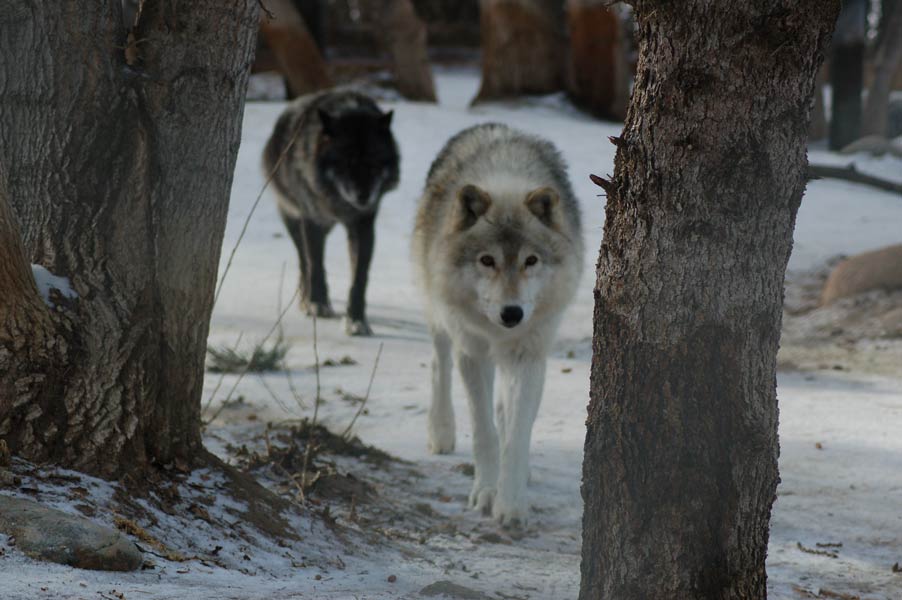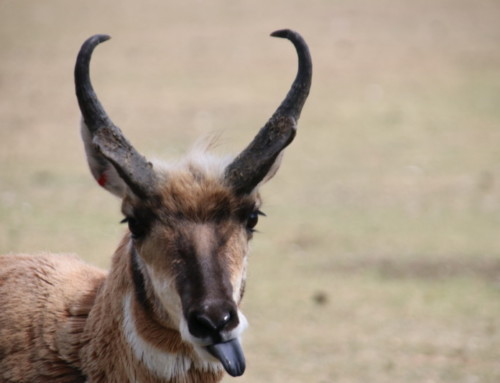The Wolves (Canis lupus)
Now this is the law of the jungle, as old and as true as the sky,
And the wolf that shall keep it may prosper, but the wolf that shall break it must die.
As the creeper that girdles the tree trunk, the law runneth forward and back;
For the strength of the pack is the wolf, and the strength of the wolf is the pack.
– Rudyard Kipling
Wolves (Canis lupus) have been on earth perhaps twice as long as modern humans have existed. They are probably the most social of all the wild dog species. Their pack structure is very sophisticated and they have strong bonds with one another. The pack includes an alpha or top male and female, youngsters and other relatives. The alpha pair, which are monogamous, are the only ones who will have pups and the members of the pack will bring food for the mother while she is raising the babies. They breed once a year with an average of 6 offspring. The female will dig a den or find a sheltered place in which to have her pups. They will remain there until the pups are several weeks old. Playing and tussling is part of their growth leading to muscle development and future prowess as a hunter. In fact, physical contact with all members of the pack leads to closeness among the pack members.
Wolves are a large part of many creation myths of North American Native peoples. They are considered a medicine being because of their strength, loyalty, courage, and hunting prowess. They, along with bears, are deemed to be very close to humans. Some Northwest tribes origin stories believed that humans originally came from the wolf. Often the wolf is considered a brother or best friend.
The wolf is the largest member of the Canidae or dog family of mammals. Their sizes range from larger in the northern groups to smaller the farther south they are found. The weight range in the males is from 30 to 80 kg with females ranging from 23 to 55 kg. Total body length ranges from 100 to 130 cm and they range from 60 to 90 cm tall at the shoulder. Fur colour ranges from pure white in the arctic groups to various shades of grey, brown, cinnamon and black. They are found over the Northern hemisphere – Canada, including the Arctic, the US, and through central Mexico, and isolated areas of Eurasia. Their habitat preferences are very wide, ranging from forests, arctic tundra, prairies, and arid deserts. They have a dense undercoat protecting them from weather extremes.
Wolves are mainly carnivores but will resort to fruits or carrion or even human garbage, if that is all that is available. They hunt cooperatively when going after larger prey such as moose, deer, musk oxen, reindeer, elk – depending on what is common in an area. They will also prey on coyotes or other wolves not of their pack. They are the top predators and help to keep ecosystems healthy by taking down sick or elderly prey. However, not all hunting expeditions are successful and the wolves can go many days without eating. Studies of the wolves reintroduced to Yellowstone National Park have shown that their influence has changed the entire ecosystem: https://www.yellowstonepark.com/things-to-do/wolf-reintroduction-changes-ecosystem
The two male wolves at the Saskatoon Forestry Farm Park and Zoo are Buddy and Zepplin. They have recently been moved to the enclosure that formerly housed Phoenix the red panda. They have more space now and a nice air-conditioned interior den for those warm summer days.
For further information on wolves: http://animaldiversity.org/accounts/Canis_lupus/


